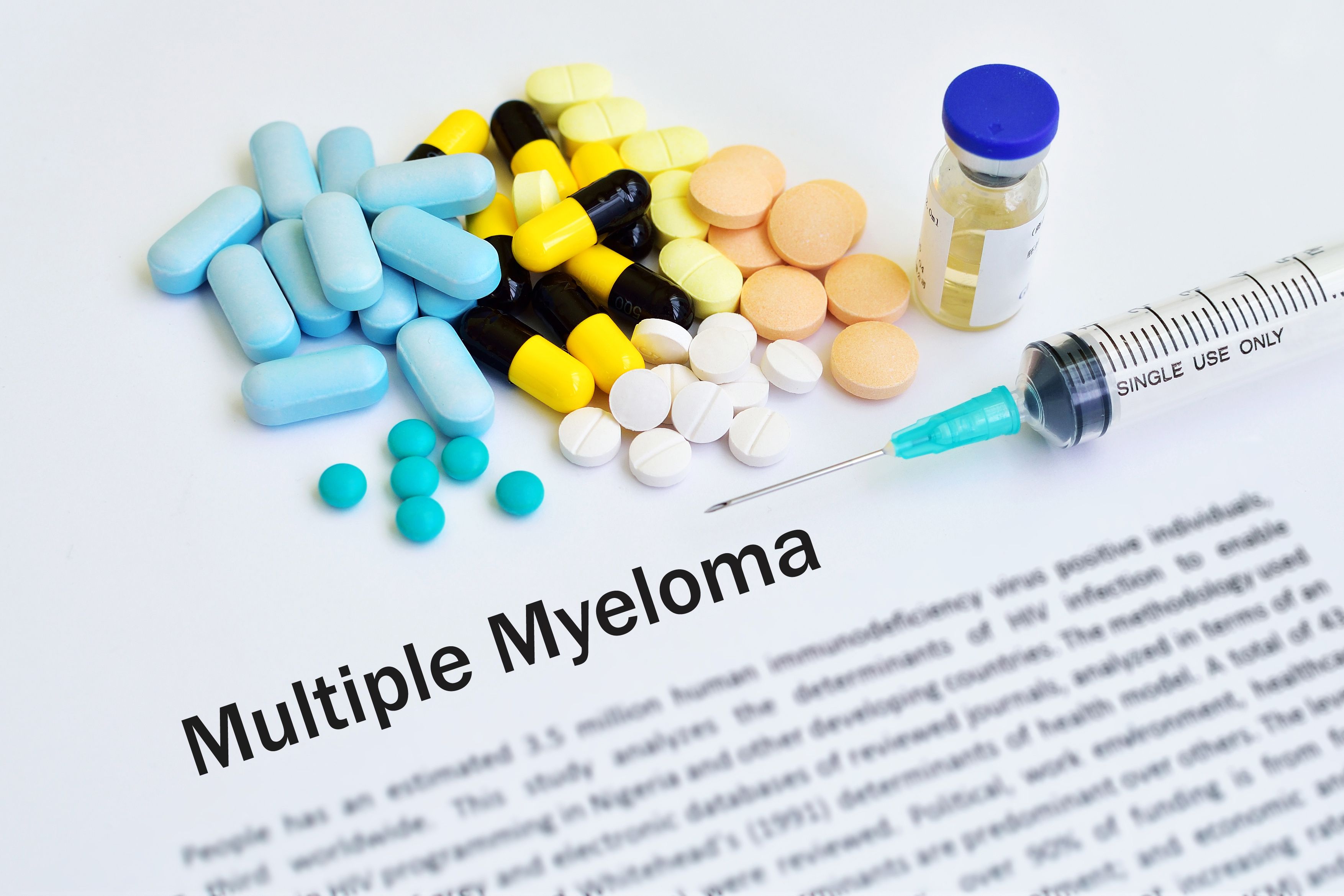Publication
Article
Transforming Blood Transfusions in Cancer Treatment
Author(s):
New technologies boost safety for patients with cancer who need donated blood.
In the seven years since Jeremy Sheldon received a chronic lymphocytic leukemia diagnosis, he has had his fair share of blood transfusions. Six months of chemotherapy initially cleared his disease, but then he developed shingles in 2017 and needed eight infusions of gamma globulin from donated plasma to replenish his declining levels of immunoglobulins — antibody proteins that are essential for maintaining immune function.
Then, in 2018, he developed myelodysplastic syndrome, another type of blood cancer that disrupts the production of blood cells, and needed a stem cell transplant. After that, he received seven transfusions of red blood cells, plus a few infusions of platelets.
“It can be scary to see this big bag of blood coming in,” says Sheldon, 55, who lives in Phoenix. He experienced some shaking and chills from the gamma globulin infusions at first, he says, but was ultimately able to tolerate most of the blood products he received and now feels confident he’s on the road to recovery. “Every day is a good day,” he says.
A PLETHORA OF PRODUCTS
Blood transfusions are routine in the treatment of patients with blood cancers. In fact, an estimated 15% of the 14 million or so blood units collected in the United States every year go to hematology and oncology patients. Although the safety of donated blood was a concern in the past, improvements in both the collection and testing of blood and its administration to patients have lessened the risks considerably. Among all patients treated with blood transfusions in 2017, the most recent year reported by the Food and Drug Administration (FDA), there were 44 deaths, down from 60 the previous year.
“The blood supply has never been safer,” says Dr. David Chow, medical director of the blood bank at Hackensack Meridian Health in New Jersey.
There are several types of transfusions that patients with blood cancers may need during the course of treatment. Patients who, like Sheldon, receive stem cell transplants are first given high doses of chemotherapy to deplete their own blood cells. That’s why after the transplant, they need transfusions of red blood cells, which carry oxygen; white blood cells to fight infections; and platelets to stem bleeding.
Even patients who don’t need stem cell transplants can develop anemia during chemotherapy treatment. Oncologists can’t prescribe drugs for anemia, such as Epogen (epoetin alfa), to patients with blood cancers because of the nature of those diseases. “Epogen can stimulate the bone marrow to produce more red blood cells, but in patients with leukemia and lymphoma, the bone marrow is not functioning,” says Dr. Qun Lu, a pathologist at Mayo Clinic in Phoenix.
For those patients, blood transfusions are considered supportive care, she adds: Even though they don’t treat the cancer itself, they relieve symptoms of anemia, like extreme exhaustion and shortness of breath, and therefore are essential for helping patients fight the disease.
Some patients with blood cancers also may need infusions of plasma and/or albumin, both of which can be used to treat liver malfunctions that can occur during the course of therapy. Plasma contains clotting factors that help contain or prevent bleeding. Cryoprecipitate is derived from plasma and has specific coagulation factors for patients with specific deficiencies. Albumin, a protein that’s abundant in blood and produced by the liver, is decreased in patients with liver disease or malnutrition and sometimes needs replacement.
AVERTING ADVERSE REACTIONS
Transfusions of red blood cells generally take between two and four hours; plasma and platelet transfusions are generally faster. During the procedure, patients are monitored frequently to make sure there are no changes in vital signs such as temperature, heart rate and blood pressure and that no adverse reactions are occurring.
Some patients who receive transfusions develop reactions that manifest with flu-like symptoms, including chills, nausea and back pain, which can be treated by lowering the rate at which the blood is given and using over-the-counter remedies like Tylenol. However, sometimes these reactions can be severe and even fatal, so all transfusions require close monitoring and preparedness to intervene.
When patients receive regular blood transfusions, they can develop a condition called iron overload. Red blood cells contain iron, so each time a patient receives a red blood cell transfusion they are putting more iron into their body. Since this can be different for each person, a doctor will decide if a patient has iron overload and if treatment, such as iron chelation therapy, is needed. In addition, patients can develop antibodies against substances known as antigens on red blood cells or platelets from donors. That can make it more difficult to find compatible blood. To locate the proper match, before a transfusion, the patient’s blood is tested for both its aBO and Rh type and for the possible presence of antibodies.
Still, it’s important for patients who have developed antibodies against donated blood to alert their physicians of their history before every transfusion — particularly if they’ve moved to a new treatment center. “Once these antibodies form, they’re considered lifelong; therefore, the patient is always at risk of having a reaction,” says Dr. Kaaron Benson, director of the blood bank at Moffitt Cancer Center in Tampa, Florida. “We may not know about it at our hospital if it happened somewhere else.”
Some patients may need to have their blood specifically tested before they even begin their cancer treatments. For example, patients with multiple myeloma, a blood cancer that forms in a plasma cell, are often prescribed Darzalex (daratumumab), a drug that’s effective at treating the cancer but also interferes with testing for blood compatibility. Those patients need to undergo special blood typing before starting Darzalex, in case they need donated blood down the road.
All donated blood components are carefully screened to ensure that donors do not unknowingly pass along viruses like HIV, hepatitis or West Nile. All platelet donations are also tested for bacterial contamination, though that testing isn’t fail-safe. That’s because unlike red blood cell units, which can be refrigerated, platelets are stored at room temperature for up to five days. “When you are storing platelets at room temperature, small amounts of bacteria can multiply into the millions and cause a severe infection,” Lu says.
Last December, a 23-year-old woman being treated for acute lymphoblastic leukemia at The University of Texas MD Anderson Cancer Center in Houston died after receiving platelets that were contaminated with bacteria. The incident prompted the federal Centers for Medicare & Medicaid Services (CMS) to review safety procedures at the hospital. The agency reported that it found a number of safety shortcomings — for example, nurses were not regularly monitoring the patient’s vital signs during the transfusion, nor had they done so for 18 other patients whose records the agency reviewed.
A spokesperson for MD Anderson said the hospital system transfuses 200,000 blood products each year, 75% of which are used in patients with hematological cancers. “We have policies and procedures in place to protect our patients. However, in rare instances, severe reactions occur,” the spokesperson said.
Since the CMS investigation, MD Anderson has reviewed all its safety procedures and retrained the nursing staff to practice more stringent patient monitoring. The hospital’s lab is also establishing a “hemovigilance unit for real-time monitoring of patients at risk for a transfusion reaction,” the spokesperson said.
BANKING ON BETTER BLOOD
Some companies are developing technologies to make the blood supply even safer. In 2014, California-based Cerus won FDA approval for its product, Intercept, which combines a chemical compound with UVA to block the ability of viruses, bacteria or parasites in donated blood to replicate. The company has shown that the technology can inactivate more than 25 different pathogens.
More than 40 blood banks have started using Intercept-screened platelets routinely, including Mayo Clinic, even though it makes obtaining blood more costly, Lu says. “It can be hundreds of thousands of dollars more in increased costs per year,” she says. “More than half the platelets we use are pathogen reduced, but we’d like it to be 100%.” Colorado-based Terumo BCT is developing Mirasol, a system that combines vitamin B2 (riboflavin) with ultraviolet light to inactivate pathogens and stray white blood cells in platelets, which can also cause reactions in some patients.
The product is approved in several countries and is being tested in clinical trials in the U.S.
Terumo hopes to apply the same technology to red blood cells, and in 2018, it started U.S. trials in patients to prove it is safe and effective.
Cerus is also working on moving its technology into the treatment of red blood cells. Many physicians welcome the idea of pretreating more than just platelets for pathogen reduction, because even though red blood cells can be refrigerated, there’s a tiny chance that some bacteria can grow in cold temperatures.
“The development process is behind for red blood cells,” says Dr. Jeffrey McCullough, professor emeritus of laboratory medicine and pathology at the University of Minnesota in Minneapolis and a consultant to both Cerus and Terumo. “But this research is moving ahead, and we expect over the next several years this will become the new paradigm for blood safety.”
To lower the risks, some oncologists infuse just one unit of blood, then wait to see if the patient needs more, rather than ordering two or more units upfront. “We used to think a two unit minimum of red blood cells for adults was important,” Benson says. “Now we have good studies showing we can lower our blood transfusion thresholds and reduce the number of units per transfusion episode, and that further reduces the risk to patients.”
Another potential development on the horizon involves freeze-dried plasma, which was used in the military in World War II but fell out of favor because it raised the risk of transmitting hepatitis B. Now that it’s possible to test donated blood for viruses, freeze-drying plasma is making a comeback. In October 2018, the FDA approved a freeze-dried plasma product made in France for emergency use by the U.S. military.
Clinical trials are underway to determine whether freeze- dried plasma is safe to use in patients with a wide range of disorders, including cancer. The product is designed to be stored up to at least one year and then mixed with sterile water for any patient who needs a transfusion. “This is something we could potentially use, particularly in the emergency setting or in remote areas,” where patients sometimes face a delay waiting for plasma, which is usually frozen, to be prepared, Benson says.
The holy grail of blood transfusion is so-called artificial blood, a blood substitute, which could provide an alternative method for carrying oxygen through the body. Several companies and academic researchers have tried to develop artificial blood but had limited success. One product, Hemopure, was approved in South Africa but rejected for approval in the U.S. after advisers to the agency suggested further studies needed to be done to prove the product’s safety and efficacy. Overall, the human trials that have been done with artificial blood have reported an increased risk of heart attack and death.
So, for the foreseeable future, donated blood is the only option for patients with cancer who need transfusions.
For that reason, oncologists often urge family members and friends of patients to donate blood to help replenish the community supply.
Still, Chow says, it’s not necessary for patients to receive donated blood from someone they know. “Patients often want their relatives to donate blood because they believe that blood is ‘cleaner,’ but that’s not the case. All blood donors are rigorously tested,” Chow says. “We want everyone to go out and donate blood. Even if the blood doesn’t help that particular patient, it will help someone.”
When blood is not needed urgently but might be anticipated after a major surgery, patients who start with normal blood counts can donate their own blood well in advance so that there is time for them to generate more blood, then have it stored and transfused back if needed because of blood loss after surgery.
For Sheldon, who still receives chemotherapy once a month, blood transfusions have become so routine that he no longer worries about the process. His advice to other patients? “Don’t be scared,” he says. “The doctors know what they’re doing, and they’re always testing, so you can have confidence that the blood they’re bringing in is the right match.” Nevertheless, it is important for all patients receiving blood products to be aware of the risks and measures taken to reduce them.





